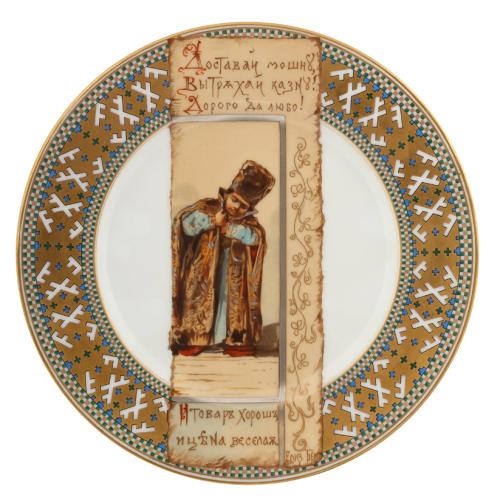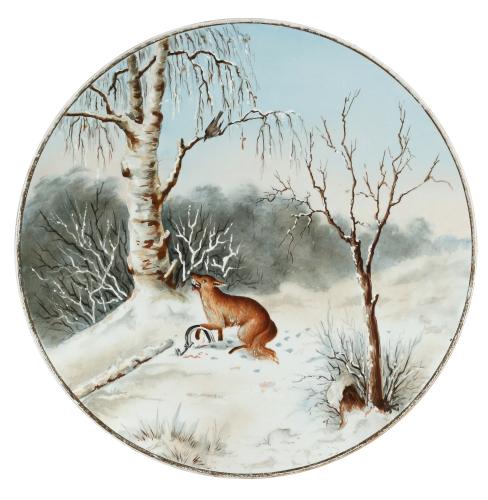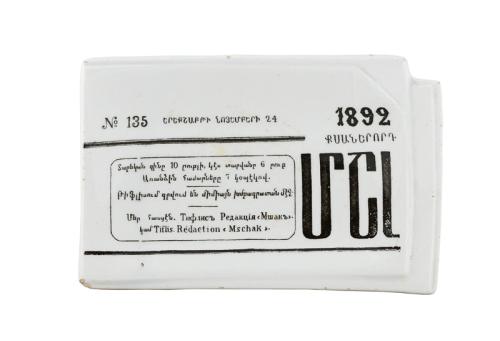
{{himg[1]}}
Porcelain, Room 2
Most of the artworks in this room are the handiwork of the Imperial Porcelain Factory's artisans. Also featured are two pieces fr om he Kuznetsov Porcelain Factory, a plate fr om the renowned export series by the Porcelain factory of the Kornilov brothers, and a couple of vases adorned with genre scenes from a private porcelain workshop.
The vases exemplify Historicism, a style merging characteristics from various styles and epochs (further detailed in the article on decorative and applied arts). Displayed here is a fusion of the grandeur and golden opulence of the Empire style with the Rococo's fascination for depicting simple peasant life. The elegance in the hairstyles, gestures, and fresh, brightly colored clothes betray a stylization far removed from the authentic peasant life of that era.
Included in the display is a plate featuring a scene from Elisaveta Merkuryevna Bem’s “fairground shout”: “Open your purse, shake out your money…”, appearing as a fragment of an ancient book page, wh ere a boy in boyar attire either beckons us or reaches for his own wallet, ready to buy “good merchandise at a merry price.” This plate is part of a series of twelve watercolors depicting children in peasant and boyar costumes with accompanying captions, created by the artist in the late 19th century for the Porcelain factory of the Kornilov brothers, catering to the foreign craze for Russian exoticism. Such pieces fr om these series are rarely seen in Russia. The book page on the plate is a trompe-l'œil (French for "deceive the eye"), a visual trick meant to amaze the unsuspecting viewer. Ilya Repin and Leo Tolstoy highly esteemed Bem's works, and she also collaborated with the Imperial Porcelain Factory.
The Porcelain Manufactory, which would later become the Imperial Porcelain Manufactory, was established in 1744 by the decree of Elizabeth Petrovna. Unlike Austria, Russia's attempt to discover the porcelain secret abroad proved unsuccessful (as elaborated in the article on Western European porcelain). Christian Konrad Hunger, an alchemist secretly brought fr om Sweden, was a fraud. However, the honor of inventing Russian porcelain goes to mining engineer Dmitry Vinogradov. He redeveloped recipes for porcelain mass and glazes, devised firing methods and designed kilns. In 1747, the factory released its first products, and by 1756, it produced the famed "Her Majesty's Own" service for grand receptions. In 1765, under Catherine II's decree, the manufacturer was renamed the Imperial Porcelain Factory. From then until the revolution (with the tsarist emblem symbolically crossed out on 1917 works), products were adorned with the imperial monogram.
During Alexander II's reign, relief images of flowers, like porcelain bouquets, were in vogue. An example in this room is the "Vase with stucco flowers," intertwining a vine in relief around the vase, shaping up to an ancient Greek amphora, and heralding Art Nouveau trends. The vase "Orchids" from Alexander III's era departs from Greek forms (its straight cylindrical shape is more akin to Japanese ceramics), and molded decorations vanish. This piece captivates with its vivid painting and intricately detailed representations of various orchid species. It employs a dual compositional technique: on one side, orchids seem to grow from the vase's base as if inside it (roots are even visible), while on the other, they form a traditional decorative bouquet. The piece achieves a striking effect by combining a minimalist form with a vibrant, varied decoration.
The 20th century ushered in shifts in tastes, fashion, and style. Markings now bear the monogram of Nicholas II, indicating the advent of Art Nouveau. The colors of the paintings turn softer and more translucent, with a more restrained color scheme. The "sprouting" composition technique continues, with cornflowers, poppies, and roses (in white and soft pink). Large flowers and bouquets still adorn the central body of the vases, yet most pieces from this era in the room introduce an innovative painting technique: flowers or leaves cascading down from the rim, covering only the upper part of the piece.
Recollections from the gardener of Grand Duke Vladimir Alexandrovich describe the palace décor of that era: “…porcelain vases with floral depictions were adorned daily with fresh flowers, those with landscape paintings were used only for special occasions” The narrative details how vases were placed throughout the palace, reflecting the abundant use of flowers in court life. The landscape-painted vases demand close examination, compelling the viewer to either circle or rotate them, creating an interactive experience with the painting.
Special attention is given to the vases with flaming glaze, wh ere a technological flaw - uneven coloration during copper firing and crystalline color inclusions - becomes an artistic statement, known as "runny glaze."
Also present are two works from the Kuznetsov Porcelain Factory (established in 1810 by Yakov Vasilyevich Kuznetsov in Gzhel): an ashtray designed as a newspaper clipping (another trompe-l'œil) and a plate depicting a scene from a well-known fable.
This collection exemplifies the diversity and uniqueness of Russian porcelain, showcasing the talent of craftsmen passionate about nature, art, and their craft. Russian porcelain, with its complex history and distinct artistic flair, stands alongside the finest European manufacturers and is esteemed worldwide.
The vases exemplify Historicism, a style merging characteristics from various styles and epochs (further detailed in the article on decorative and applied arts). Displayed here is a fusion of the grandeur and golden opulence of the Empire style with the Rococo's fascination for depicting simple peasant life. The elegance in the hairstyles, gestures, and fresh, brightly colored clothes betray a stylization far removed from the authentic peasant life of that era.
Included in the display is a plate featuring a scene from Elisaveta Merkuryevna Bem’s “fairground shout”: “Open your purse, shake out your money…”, appearing as a fragment of an ancient book page, wh ere a boy in boyar attire either beckons us or reaches for his own wallet, ready to buy “good merchandise at a merry price.” This plate is part of a series of twelve watercolors depicting children in peasant and boyar costumes with accompanying captions, created by the artist in the late 19th century for the Porcelain factory of the Kornilov brothers, catering to the foreign craze for Russian exoticism. Such pieces fr om these series are rarely seen in Russia. The book page on the plate is a trompe-l'œil (French for "deceive the eye"), a visual trick meant to amaze the unsuspecting viewer. Ilya Repin and Leo Tolstoy highly esteemed Bem's works, and she also collaborated with the Imperial Porcelain Factory.
The Porcelain Manufactory, which would later become the Imperial Porcelain Manufactory, was established in 1744 by the decree of Elizabeth Petrovna. Unlike Austria, Russia's attempt to discover the porcelain secret abroad proved unsuccessful (as elaborated in the article on Western European porcelain). Christian Konrad Hunger, an alchemist secretly brought fr om Sweden, was a fraud. However, the honor of inventing Russian porcelain goes to mining engineer Dmitry Vinogradov. He redeveloped recipes for porcelain mass and glazes, devised firing methods and designed kilns. In 1747, the factory released its first products, and by 1756, it produced the famed "Her Majesty's Own" service for grand receptions. In 1765, under Catherine II's decree, the manufacturer was renamed the Imperial Porcelain Factory. From then until the revolution (with the tsarist emblem symbolically crossed out on 1917 works), products were adorned with the imperial monogram.
During Alexander II's reign, relief images of flowers, like porcelain bouquets, were in vogue. An example in this room is the "Vase with stucco flowers," intertwining a vine in relief around the vase, shaping up to an ancient Greek amphora, and heralding Art Nouveau trends. The vase "Orchids" from Alexander III's era departs from Greek forms (its straight cylindrical shape is more akin to Japanese ceramics), and molded decorations vanish. This piece captivates with its vivid painting and intricately detailed representations of various orchid species. It employs a dual compositional technique: on one side, orchids seem to grow from the vase's base as if inside it (roots are even visible), while on the other, they form a traditional decorative bouquet. The piece achieves a striking effect by combining a minimalist form with a vibrant, varied decoration.
The 20th century ushered in shifts in tastes, fashion, and style. Markings now bear the monogram of Nicholas II, indicating the advent of Art Nouveau. The colors of the paintings turn softer and more translucent, with a more restrained color scheme. The "sprouting" composition technique continues, with cornflowers, poppies, and roses (in white and soft pink). Large flowers and bouquets still adorn the central body of the vases, yet most pieces from this era in the room introduce an innovative painting technique: flowers or leaves cascading down from the rim, covering only the upper part of the piece.
Recollections from the gardener of Grand Duke Vladimir Alexandrovich describe the palace décor of that era: “…porcelain vases with floral depictions were adorned daily with fresh flowers, those with landscape paintings were used only for special occasions” The narrative details how vases were placed throughout the palace, reflecting the abundant use of flowers in court life. The landscape-painted vases demand close examination, compelling the viewer to either circle or rotate them, creating an interactive experience with the painting.
Special attention is given to the vases with flaming glaze, wh ere a technological flaw - uneven coloration during copper firing and crystalline color inclusions - becomes an artistic statement, known as "runny glaze."
Also present are two works from the Kuznetsov Porcelain Factory (established in 1810 by Yakov Vasilyevich Kuznetsov in Gzhel): an ashtray designed as a newspaper clipping (another trompe-l'œil) and a plate depicting a scene from a well-known fable.
This collection exemplifies the diversity and uniqueness of Russian porcelain, showcasing the talent of craftsmen passionate about nature, art, and their craft. Russian porcelain, with its complex history and distinct artistic flair, stands alongside the finest European manufacturers and is esteemed worldwide.



































